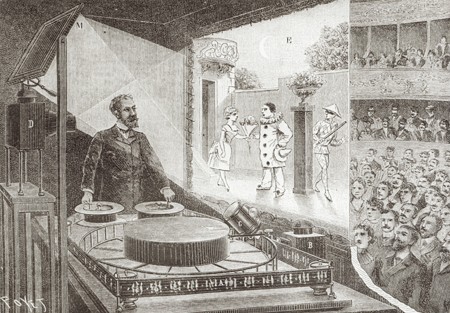The book on which I have been working is conceived as both a historical and a theoretical probing of the conception and realization of the moving image. A large part of the project therefore lies in defining the moving image. I am primarily a film historian, with much of my work focused on early cinema (from approximately 1889 to 1917). But the term “moving image” is more than an oblique way to refer to cinema. Today, when the filmstrip as a physical medium is being replaced by electronic images, we realize how contingent the forms of cinema can be. The theatrically presented movie seems to be giving way to a range of platforms for watching moving images: television monitors, computer screens, even smart phones.
Although some critics have bemoaned this transformation as the death of cinema, I see it more as an opportunity to extend our understanding of the history of the medium and realize that, even before the invention of film, moving images held an important place in entertainment and scientific research. Therefore, much of my research has concerned the various moving-image devices that existed before film, especially those that appeared in the nineteenth century. Often referred to as “philosophical toys” and merchandised as educational playthings, devices such as the phenakistiscope, the zoetrope, and the praxinoscope explored the way in which a series of still images rapidly presented could interact with human perception to yield an image that appeared to move. I refer to this unique type of image, simultaneously technological and perceptual, as a moving image. As something generated through our perception, it is also in a sense immaterial, perhaps best described as “virtual.”
During my residency at CASVA I researched the manner in which a
variety of images present movement, not only modernist works such as those of the futurists (who were influenced by technological moving images) but also more pictorial painting and photography, which portrayed mobile phenomena such as waves or clouds. I read a number of texts (including some rare ones) by French physiologist Étienne Jules Marey, whose study of locomotion led to new ways in which photography could record motion. Marey’s use of photography to analyze motion as a series of discrete images achieved an essential stage in the synthesis and projection of photographic motion pictures.
My exploration of the technological and virtual nature of moving images has also led me increasingly to consider the projected image; in fact, I now define my subject as the invention of the moving and the projected image. Not only do most moving-image systems rely on some form of projection; the projected image defines aspects of the virtual image. A projected image is created by light directed through a lens onto a screen or surface. Formed of projected and reflected light, it is essentially immaterial and very different from the traditional picture in a medium affixed to a material surface.
The moving image first appears in the nineteenth century, but the projected image has a history that extends back much farther. This expanded focus has led me to a consideration of the roots of the projected image in the science of optics (the investigation of light and sight) and its theories of imagery. Therefore, while at CASVA I also read intensively in the medieval synthesis and reworking of classical and Arabic theories of light and vision in texts by Roger Bacon and John Pecham, in which theories of images are embedded in the study of the nature of light and vision.
Working on such questions at CASVA has led me to consider the moving and projected image not simply as an aspect of the history of film or newer media but one that extends through the longue durée of image making. Thinking within the tradition of art history allows me to describe precisely the innovation that these technological and virtual images initiated as well as their relation to more traditional images.
